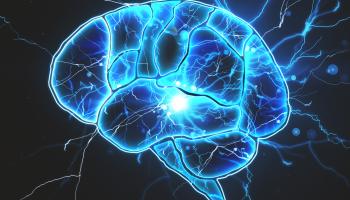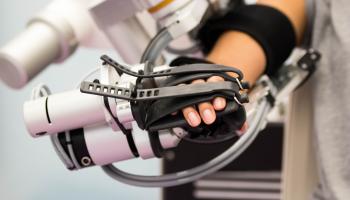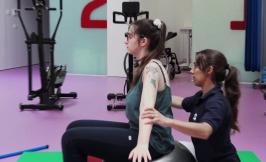Parkinson's disease
Parkinson’s disease is a progressive disease of the nervous system that arises when certain neurons no longer produce a chemical called dopamine. Although the disease mainly affects movement, other cognitive or mood aspects can also be affected.
The symptoms start gradually, generally at around 60 years old, although they can start much earlier or later. The disease is more common in men than women and initially it usually affects one side of the body more than the other. Typical symptoms are shaking, rigidity, slow movements, and balance and coordination disorders.
Emotional problems are often associated with Parkinson’s disease, and they can even be seen before movement problems. As the disease evolves, as well as worsening motor skills there can be associated problems with cognition, swallowing, speaking, sleep and sexual performance, as well as control over sphincters.
Although there is no cure for Parkinson’s disease, pharmacologic treatment can notably help improve symptoms. Doctors may sometimes suggest surgery to regulate certain areas of the brain and improve symptoms. Rehabilitation is used to improve the mobility and quality of life of patients with Parkinson’s disease and should be adapted to the stage they are at. As well as preventing complications, this approach can have a positive effect on mood, cognitive problems or the risk of falls.
- Symptoms of Parkinson's Disease
-
The signs and symptoms of Parkinson’s disease can differ in each person. The first signs can be slight and unnoticeable. Symptoms often start on one side of the body and usually continue to worsen on the same side, even after the symptoms have started to affect both sides. Parkinson’s disease can initially be manifested with mood problems or even depression (being difficult to diagnose during this phase).
Signs and symptoms of Parkinson’s disease:
- Shaking. Shaking in Parkinson’s disease generally starts in one extremity, often the hand or fingers. It can appear as an involuntary rubbing of the thumb and fingers (pill rolling tremor) and the hand may shake when it is in a resting position.
- Slow movement (bradykinesia). Over time, Parkinson’s disease can slow down the patient’s normal movements, making simple tasks more difficult and time-consuming. Steps can be short and patients drag their feet when they walk.
- Muscular rigidity. Muscular rigidity can appear in any part of the body. Rigid muscles can be painful and limit a person’s range of movement.
- Alterations in posture and balance. The posture can become curved and balance problems can also appear.
- Loss of automatic movements. Patients may have a reduced ability to make unconscious movements, such as blinking, laughing and swinging the arms when walking.
- Changes in speech. Changes in speech can be produced, such as speaking more softly or more quickly, hesitating before speaking and having a more monotone delivery due to a loss of inflection.
- Changes in writing. Writing may become harder to do and the letters may be smaller.
- Causes of Parkinson's sisease
-
In Parkinson’s disease, some of the brain’s neurons break down or gradually die. Many of the symptoms obey a loss of the neurons that produce dopamine, a type of chemical messenger within the brain. When dopamine levels fall, this leads to an anomaly in brain activity, causing the symptoms of Parkinson’s disease.
The cause of Parkinson’s disease is unknown, but several factors seem to play a role, such as:
- Genetics: Researchers have identified specific genetic mutations that can cause Parkinson’s disease. They are quite rare, with the exception of some cases in which many members of the family suffer from the disease. Nevertheless, certain genetic variations seem to increase the risk of suffering from Parkinson’s disease.
- Age: Young adults rarely suffer from Parkinson’s disease. The disease begins in mid or advanced stages of life, and the risk increases with age. Patients normally manifest with Parkinson’s disease after the age of 60.
- Sex: Men have a higher propensity to develop Parkinson’s disease than women.
- Environmental triggers: Exposure to certain toxins or environmental factors can increase the risk of suffering from Parkinson’s disease in the future.
- Complications in Parkinson's disease
-
Parkinson’s disease is often accompanied by additional problems that can be improved by treating the symptoms:
- Difficulty thinking. Cognitive problems and/or dementia. This is usually seen in the most advanced stages of Parkinson’s disease. In some patients there may be a moderate response to drugs used to treat these disorders in Alzheimer’s disease.
- Depression and emotional changes. It is possible that the patient will suffer from depression, sometimes during the early stages of the disease. Treatment for depression can help treat other difficulties caused by the disease. It is also possible for patients to experience other emotional changes like fear, anxiety or loss of motivation.
- Problems swallowing. It is likely that difficulties with swallowing will develop as the disease develops. Saliva can accumulate in the mouth due to swallowing slowly. Problems chewing and eating. Parkinson’s disease in its advanced stages affects the muscles of the mouth, making chewing difficult. This can lead to choking and malnutrition.
- Problems sleeping and sleep disorders.
- Bladder problems. Parkinson’s disease can lead to bladder problems, including the inability to hold in urine.
- Constipation. Many people with Parkinson’s disease suffer from constipation, mainly because their digestive system functions more slowly.
- Sexual dysfunction. In some cases, patients with Parkinson’s disease report a reduction in sexual desire or in sexual performance.
- Rehabilitation in Parkinson’s disease and parkinsonisms
-
This group of diseases affects core mobility, but also has an impact on other areas like emotions, cognition, sleep, etc. As well as the use of drugs, rehabilitation is also therefore necessary to comprehensively address all possible problems.
- Physiotherapy: to maintain a good range of movement and prevent complications (joints, pain).
- Occupational therapy: the aim is to delay dependence as far as possible and maintain as much functionality as possible.
- Aerobic exercise to improve fatigue and overall quality of life.
- Individual and group exercises (including those done in the pool) to improve coordination and balance, improving gait and reducing the risk of falls. Of particular interest are those that develop rhythmic skills (using sounds or patterns, such as tai-chi).
- Treatment to improve cognitive functions wherever relevant.
- Monitoring and emotional support, using different techniques like mindfulness in order to improve quality of life.
Cognitive rehabilitation with Guttmann, NeuroPersonalTrainer® is neuropsychological rehabilitation treatment, which is an active process that helps the patient to optimise the recovery of higher functions (attention, perception, memory, executive functions, calculation...) to better understand the alterations presented and to develop strategies to compensate f

This personalised training and improved functionality programme is aimed at optimising and maintaining functional capabilities, as well as preventing complications associated with disability issues.
Transcranial magnetic stimulation (TMS) for the treatment of depression is aimed at people with or without neurological issues who have been diagnosed with treatment-resistant major depression; that is, when they have not responded to treatment with different antidepressant medications which have been taken properly.

Neuropsychological rehabilitation or neuropsychological treatment is an active process that helps patients and their families to better understand the difficulties they present, develop strategies that optimize their higher functions, compensate for neuropsychological disorders and optimize higher functions.

Guttmann Barcelona offers a treatment programme of physiotherapy and gait rehabilitation in a group, with sessions based on shared rehabilitation goals, with activities being planned around these goals in both the rehabilitation room and the swimming pool.

Guttmann Barcelona has launched its programme of psychology group sessions, as the social aspects associated with group therapy provide additional benefits to those of the treatment itself, due to the positive impact that spending time with other people has on our mood and cognitive response.

The Comprehensive Memory Stimulation Program aims to prevent and / or slow down the cognitive and physical deterioration of people suffering from neurodegenerative diseases.
Et pot interessar
 Friday, 08 January, 2021
Brain Health for Life. Preventing Brain-Related Disability.
Friday, 08 January, 2021
Brain Health for Life. Preventing Brain-Related Disability.
Research is providing information on the effects of each of these factors and the best way to use them in our favor. Because, in addition to...
 Tuesday, 08 September, 2020
Mindfulness: benefits and practice
Tuesday, 08 September, 2020
Mindfulness: benefits and practice
BENEFITS OF THE PRACTICE OF MINDFULNESS We will improve our ability to cope with difficulties and conflict situations. We will acquire more...
 Monday, 16 March, 2020
The use of technology in neurorehabilitation
Monday, 16 March, 2020
The use of technology in neurorehabilitation
Over the past 25 years, it has been found that the efficacy of conventional physical and / or occupational therapy applied during...


